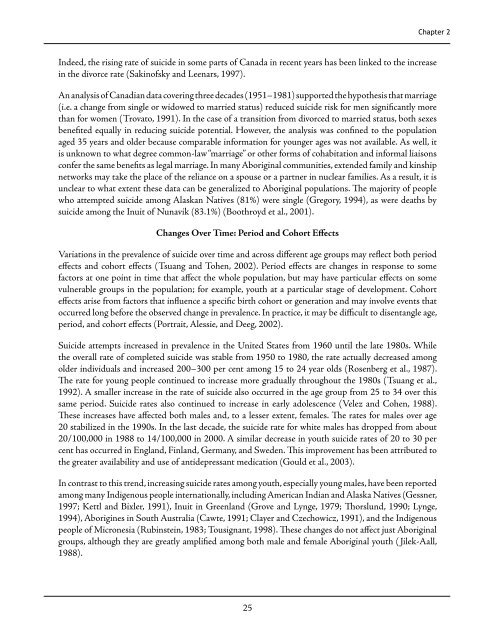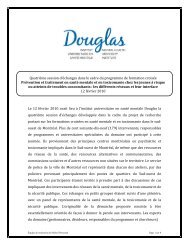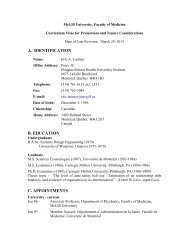Suicide Among Aboriginal People in Canada - Institut universitaire ...
Suicide Among Aboriginal People in Canada - Institut universitaire ...
Suicide Among Aboriginal People in Canada - Institut universitaire ...
Create successful ePaper yourself
Turn your PDF publications into a flip-book with our unique Google optimized e-Paper software.
Chapter 2Indeed, the ris<strong>in</strong>g rate of suicide <strong>in</strong> some parts of <strong>Canada</strong> <strong>in</strong> recent years has been l<strong>in</strong>ked to the <strong>in</strong>crease<strong>in</strong> the divorce rate (Sak<strong>in</strong>ofsky and Leenars, 1997).An analysis of Canadian data cover<strong>in</strong>g three decades (1951–1981) supported the hypothesis that marriage(i.e. a change from s<strong>in</strong>gle or widowed to married status) reduced suicide risk for men significantly morethan for women (Trovato, 1991). In the case of a transition from divorced to married status, both sexesbenefited equally <strong>in</strong> reduc<strong>in</strong>g suicide potential. However, the analysis was conf<strong>in</strong>ed to the populationaged 35 years and older because comparable <strong>in</strong>formation for younger ages was not available. As well, itis unknown to what degree common-law “marriage” or other forms of cohabitation and <strong>in</strong>formal liaisonsconfer the same benefits as legal marriage. In many <strong>Aborig<strong>in</strong>al</strong> communities, extended family and k<strong>in</strong>shipnetworks may take the place of the reliance on a spouse or a partner <strong>in</strong> nuclear families. As a result, it isunclear to what extent these data can be generalized to <strong>Aborig<strong>in</strong>al</strong> populations. The majority of peoplewho attempted suicide among Alaskan Natives (81%) were s<strong>in</strong>gle (Gregory, 1994), as were deaths bysuicide among the Inuit of Nunavik (83.1%) (Boothroyd et al., 2001).Changes Over Time: Period and Cohort EffectsVariations <strong>in</strong> the prevalence of suicide over time and across different age groups may reflect both periodeffects and cohort effects (Tsuang and Tohen, 2002). Period effects are changes <strong>in</strong> response to somefactors at one po<strong>in</strong>t <strong>in</strong> time that affect the whole population, but may have particular effects on somevulnerable groups <strong>in</strong> the population; for example, youth at a particular stage of development. Cohorteffects arise from factors that <strong>in</strong>fluence a specific birth cohort or generation and may <strong>in</strong>volve events thatoccurred long before the observed change <strong>in</strong> prevalence. In practice, it may be difficult to disentangle age,period, and cohort effects (Portrait, Alessie, and Deeg, 2002).<strong>Suicide</strong> attempts <strong>in</strong>creased <strong>in</strong> prevalence <strong>in</strong> the United States from 1960 until the late 1980s. Whilethe overall rate of completed suicide was stable from 1950 to 1980, the rate actually decreased amongolder <strong>in</strong>dividuals and <strong>in</strong>creased 200–300 per cent among 15 to 24 year olds (Rosenberg et al., 1987).The rate for young people cont<strong>in</strong>ued to <strong>in</strong>crease more gradually throughout the 1980s (Tsuang et al.,1992). A smaller <strong>in</strong>crease <strong>in</strong> the rate of suicide also occurred <strong>in</strong> the age group from 25 to 34 over thissame period. <strong>Suicide</strong> rates also cont<strong>in</strong>ued to <strong>in</strong>crease <strong>in</strong> early adolescence (Velez and Cohen, 1988).These <strong>in</strong>creases have affected both males and, to a lesser extent, females. The rates for males over age20 stabilized <strong>in</strong> the 1990s. In the last decade, the suicide rate for white males has dropped from about20/100,000 <strong>in</strong> 1988 to 14/100,000 <strong>in</strong> 2000. A similar decrease <strong>in</strong> youth suicide rates of 20 to 30 percent has occurred <strong>in</strong> England, F<strong>in</strong>land, Germany, and Sweden. This improvement has been attributed tothe greater availability and use of antidepressant medication (Gould et al., 2003).In contrast to this trend, <strong>in</strong>creas<strong>in</strong>g suicide rates among youth, especially young males, have been reportedamong many Indigenous people <strong>in</strong>ternationally, <strong>in</strong>clud<strong>in</strong>g American Indian and Alaska Natives (Gessner,1997; Kettl and Bixler, 1991), Inuit <strong>in</strong> Greenland (Grove and Lynge, 1979; Thorslund, 1990; Lynge,1994), Aborig<strong>in</strong>es <strong>in</strong> South Australia (Cawte, 1991; Clayer and Czechowicz, 1991), and the Indigenouspeople of Micronesia (Rub<strong>in</strong>ste<strong>in</strong>, 1983; Tousignant, 1998). These changes do not affect just <strong>Aborig<strong>in</strong>al</strong>groups, although they are greatly amplified among both male and female <strong>Aborig<strong>in</strong>al</strong> youth ( Jilek-Aall,1988).25
















